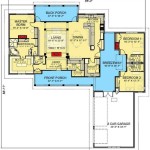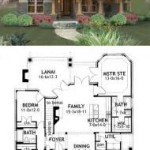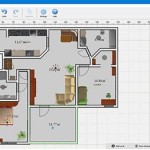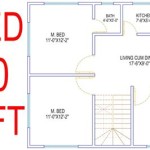Accessible house plans are architectural designs that prioritize accessibility and ease of use for individuals with disabilities. These plans incorporate features that allow for convenient and safe navigation, such as wider doorways, ramps, and roll-in showers. An example of an accessible house plan is one that includes a zero-step entry, allowing individuals with mobility impairments to enter the home without encountering steps or obstacles.
Accessible house plans play a crucial role in creating inclusive living environments. By providing a barrier-free space, they empower individuals with disabilities to live independently and with dignity. In addition to the functional benefits, accessible house plans also contribute to a more inclusive and equitable society.
In the following sections, we will delve into the key considerations and benefits of accessible house plans, exploring their impact on individuals with disabilities, their families, and society as a whole.
Accessible house plans incorporate key features that promote ease of use and safety for individuals with disabilities.
- Wider doorways: Allow for easy passage of wheelchairs and mobility aids.
- Ramps: Provide gradual slopes for accessing different levels.
- Roll-in showers: Eliminate the need for stepping over a barrier.
- Grab bars: Offer support and stability in bathrooms and other areas.
- Lowered countertops: Ensure accessibility for individuals in wheelchairs.
- Lever door handles: Replace knobs for easier operation.
- Non-slip flooring: Reduce the risk of falls.
- Accessible appliances: Feature easy-to-reach controls and adjustments.
- Universal design principles: Create spaces that can be used by people of all abilities.
By incorporating these features, accessible house plans create inclusive living environments that empower individuals with disabilities to live independently and with dignity.
Wider doorways: Allow for easy passage of wheelchairs and mobility aids.
Wider doorways are a crucial feature of accessible house plans as they ensure that individuals using wheelchairs or other mobility aids can easily navigate through the home. Standard doorways typically measure around 32 inches in width, which can be too narrow for wheelchairs that are typically 25-27 inches wide. Wider doorways, on the other hand, provide ample space for wheelchairs to pass through without any difficulty.
The width of accessible doorways is determined by the specific needs of the individuals who will be using the space. For example, if the doorway will be used by someone who uses a power wheelchair, a wider doorway of at least 36 inches is recommended. Additionally, it is important to consider the turning radius of the wheelchair when determining the appropriate doorway width.
In addition to wheelchairs, wider doorways also benefit individuals using other mobility aids, such as walkers, canes, and scooters. By providing a wider opening, individuals can move through doorways more easily and safely, reducing the risk of accidents or falls.
Wider doorways not only enhance accessibility but also contribute to a more inclusive living environment. They allow individuals with disabilities to participate fully in household activities and social interactions, fostering a sense of belonging and independence.
Ramps: Provide gradual slopes for accessing different levels.
Ramps are inclined surfaces that provide a gradual slope for accessing different levels within a home. They are an essential feature of accessible house plans as they allow individuals using wheelchairs or other mobility aids to navigate between floors and rooms without encountering barriers.
Ramps should be designed to meet specific slope requirements to ensure safety and ease of use. The slope of a ramp is typically measured in terms of its rise and run. The rise is the vertical height of the ramp, while the run is the horizontal length of the ramp. The ideal slope for a ramp is 1:12, which means that for every 1 inch of rise, there should be 12 inches of run. This slope provides a gradual incline that is easy to navigate for individuals using wheelchairs or other mobility aids.
In addition to the slope, the width of the ramp is also important. Ramps should be at least 36 inches wide to allow for safe passage of wheelchairs. The surface of the ramp should be non-slip and have a firm, stable base to prevent accidents.
Ramps can be installed both indoors and outdoors. Indoor ramps are typically used to connect different levels within a home, such as between the main floor and a basement or between a bedroom and a bathroom. Outdoor ramps are used to provide access to the home from the outside, such as from a driveway or patio.
Ramps play a crucial role in accessible house plans by providing a safe and convenient way for individuals with disabilities to access different levels of the home. They promote independence and allow individuals to participate fully in household activities and social interactions.
Roll-in showers: Eliminate the need for stepping over a barrier.
Roll-in showers are a type of accessible shower that is designed to be accessible to individuals using wheelchairs or other mobility aids. They are characterized by a curbless entry, which eliminates the need for stepping over a barrier to enter the shower. This makes roll-in showers a safe and convenient option for individuals with mobility impairments.
Roll-in showers typically have a sloped floor that drains water towards a drain located at the back of the shower. This design ensures that the shower floor is level and free of any obstacles, making it easy for individuals using wheelchairs to roll into the shower and maneuver safely.
In addition to the curbless entry and sloped floor, roll-in showers often include other accessible features, such as:
- Grab bars for support and stability
- A built-in seat for resting
- A handheld showerhead for convenience
- Non-slip flooring to prevent falls
Roll-in showers are an essential feature of accessible house plans as they provide a safe and dignified way for individuals with mobility impairments to bathe independently. They promote independence and allow individuals to maintain their privacy and dignity.
When designing a roll-in shower, it is important to consider the specific needs of the individual who will be using it. Factors to consider include the individual’s height, weight, and mobility level. It is also important to ensure that the shower is large enough to accommodate the individual’s wheelchair and any necessary equipment, such as a shower chair or commode.
Roll-in showers are a valuable addition to any accessible house plan. They provide a safe and convenient way for individuals with mobility impairments to bathe independently, promoting their independence and quality of life.
Grab bars: Offer support and stability in bathrooms and other areas.
Grab bars are an essential accessibility feature in bathrooms and other areas of the home. They provide support and stability for individuals with mobility impairments, allowing them to move safely and independently. Grab bars are typically installed in areas where individuals are most likely to need assistance, such as near toilets, showers, bathtubs, and sinks.
Grab bars come in a variety of shapes and sizes to accommodate different needs. They can be straight, angled, or curved, and they can be mounted horizontally, vertically, or diagonally. Grab bars should be installed securely into studs or other solid supports to ensure that they can withstand the weight of an individual using them.
In bathrooms, grab bars are typically installed near toilets, showers, and bathtubs. They provide support for individuals getting on and off the toilet, entering and exiting the shower or bathtub, and standing up from a seated position. Grab bars can also be installed in other areas of the bathroom, such as near the sink or vanity, to provide support for individuals while brushing their teeth, washing their hands, or performing other tasks.
In addition to bathrooms, grab bars can also be installed in other areas of the home where individuals may need support and stability. For example, grab bars can be installed in hallways, stairwells, and entryways to provide support for individuals walking or using mobility aids. Grab bars can also be installed in kitchens, laundry rooms, and other areas of the home where individuals may need assistance with tasks such as cooking, cleaning, or getting dressed.
Grab bars are an important accessibility feature that can help individuals with mobility impairments live independently and safely. They provide support and stability in bathrooms and other areas of the home, allowing individuals to move around with confidence and ease.
Lowered countertops: Ensure accessibility for individuals in wheelchairs.
Lowered countertops are an essential accessibility feature in kitchens and other areas of the home where individuals in wheelchairs need to be able to reach and use the countertop. Standard countertops are typically installed at a height of around 36 inches, which can be too high for individuals in wheelchairs to reach comfortably. Lowered countertops, on the other hand, are installed at a height that is accessible to individuals in wheelchairs, typically between 28 and 32 inches.
- Allow for independent meal preparation: Lowered countertops enable individuals in wheelchairs to independently prepare meals and perform other kitchen tasks without assistance. They can reach the countertop, stovetop, and sink without having to strain or overextend themselves.
- Promote dignity and self-reliance: Lowered countertops foster a sense of dignity and self-reliance among individuals in wheelchairs. They can perform everyday tasks without having to rely on others for assistance, which contributes to their overall well-being and quality of life.
- Provide a comfortable and safe workspace: Lowered countertops create a comfortable and safe workspace for individuals in wheelchairs. They can work at the countertop for extended periods without experiencing discomfort or fatigue.
- Accommodate different heights and needs: Lowered countertops can be customized to accommodate the specific height and needs of the individual using them. This ensures that everyone can access and use the countertop safely and comfortably.
Lowered countertops are an essential accessibility feature that can make a significant difference in the lives of individuals in wheelchairs. They promote independence, dignity, and safety, and allow individuals to fully participate in household activities.
Lever door handles: Replace knobs for easier operation.
Lever door handles are an accessibility feature that can make a significant difference for individuals with limited hand mobility or dexterity. They replace traditional round door knobs, which can be difficult to grip and turn for some individuals.
- Easier to grip: Lever door handles are designed with a long, flat lever that is easy to grip and operate with minimal hand strength. This makes them ideal for individuals with arthritis, carpal tunnel syndrome, or other conditions that affect hand mobility.
- Reduced pain and strain: Lever door handles require less force to operate than round door knobs. This can reduce pain and strain in the hands, wrists, and arms, making it easier for individuals to open and close doors without discomfort.
- One-handed operation: Lever door handles can be operated with one hand, which is beneficial for individuals with limited use of one arm or hand. This allows them to open and close doors independently, without having to rely on assistance from others.
- Accommodate different heights: Lever door handles can be installed at different heights to accommodate individuals of different heights and abilities. This ensures that everyone can reach and operate the door handle comfortably.
Lever door handles are an important accessibility feature that can make a significant difference in the lives of individuals with limited hand mobility or dexterity. They promote independence, reduce pain and strain, and allow individuals to fully participate in household activities.
Non-slip flooring: Reduce the risk of falls.
Non-slip flooring is an essential accessibility feature that can significantly reduce the risk of falls, especially for individuals with mobility impairments or balance issues. It provides a stable and secure surface for individuals to walk and move around on, reducing the likelihood of slipping and falling.
Non-slip flooring is typically made of materials that have a high coefficient of friction, which means that they provide a good grip and prevent slipping. Common non-slip flooring materials include:
- Rubber
- Cork
- Vinyl
- Laminate
- Textured tile
Non-slip flooring can be installed in any area of the home, but it is particularly important in areas where individuals are more likely to slip and fall, such as bathrooms, kitchens, and hallways. It is also important to consider the specific needs of the individual using the space when selecting non-slip flooring. For example, individuals with severe mobility impairments may require a flooring material with a higher coefficient of friction to ensure maximum stability.
In addition to reducing the risk of falls, non-slip flooring also provides other benefits, such as:
- Improved mobility: Non-slip flooring makes it easier for individuals to walk and move around safely, which can improve their mobility and independence.
- Reduced pain and discomfort: Non-slip flooring can help to reduce pain and discomfort caused by falls or slips.
- Increased confidence: Non-slip flooring can give individuals peace of mind and increased confidence when walking and moving around, as they know that they are less likely to slip and fall.
Non-slip flooring is an essential accessibility feature that can make a significant difference in the lives of individuals with mobility impairments or balance issues. It promotes safety, improves mobility, and reduces the risk of falls, allowing individuals to live independently and with dignity.
Accessible appliances: Feature easy-to-reach controls and adjustments.
Accessible appliances are designed with features that make them easier to use for individuals with disabilities or limited mobility. These features include easy-to-reach controls and adjustments, which allow individuals to operate appliances without having to strain or overextend themselves.
One important aspect of accessible appliances is the placement of controls. Controls should be located within easy reach of individuals in wheelchairs or with limited mobility. This means that controls should be placed at a height that is accessible from a seated position and should not require excessive reaching or bending.
Another important aspect of accessible appliances is the design of the controls themselves. Controls should be easy to grip and operate, even for individuals with limited hand mobility or dexterity. This means that controls should be large enough to be easily grasped and should not require excessive force to operate.
In addition to the placement and design of controls, accessible appliances may also include other features that make them easier to use for individuals with disabilities. For example, some appliances may have adjustable heights or features that allow them to be operated with one hand.
Accessible appliances are an important part of accessible house plans. They allow individuals with disabilities or limited mobility to live independently and with dignity by providing them with the ability to use appliances safely and conveniently.
Universal design principles: Create spaces that can be used by people of all abilities.
Universal design principles are a set of guidelines that aim to create spaces and products that are accessible to and usable by people of all abilities, including people with disabilities, the elderly, and children. When applied to accessible house plans, universal design principles can help to create homes that are safe, comfortable, and convenient for everyone.
One important aspect of universal design is the concept of flexibility. Universal design principles encourage the use of adjustable and adaptable features that can be customized to meet the needs of different users. For example, adjustable-height countertops and sinks allow individuals of different heights to use the kitchen comfortably. Similarly, adaptable storage solutions, such as adjustable shelves and pull-out drawers, make it easier for individuals with limited mobility to access items.
Another key principle of universal design is simplicity. Universal design principles encourage the use of simple and intuitive designs that are easy to understand and use. This means avoiding complex or confusing controls and interfaces, and opting for designs that are clear and straightforward. For example, lever door handles are easier to operate than round doorknobs, and single-lever faucets are easier to control than two-handle faucets.
Universal design principles also emphasize the importance of providing multiple means of access and use. This means providing different ways for people to interact with and use a space or product. For example, accessible house plans should provide multiple ways to enter and exit the home, such as ramps, stairs, and elevators. Similarly, kitchens should provide multiple ways to access appliances and storage, such as adjustable-height countertops and pull-out drawers.
By incorporating universal design principles into accessible house plans, it is possible to create homes that are safe, comfortable, and convenient for everyone. Universal design principles help to create inclusive spaces that allow people of all abilities to live independently and with dignity.










Related Posts








